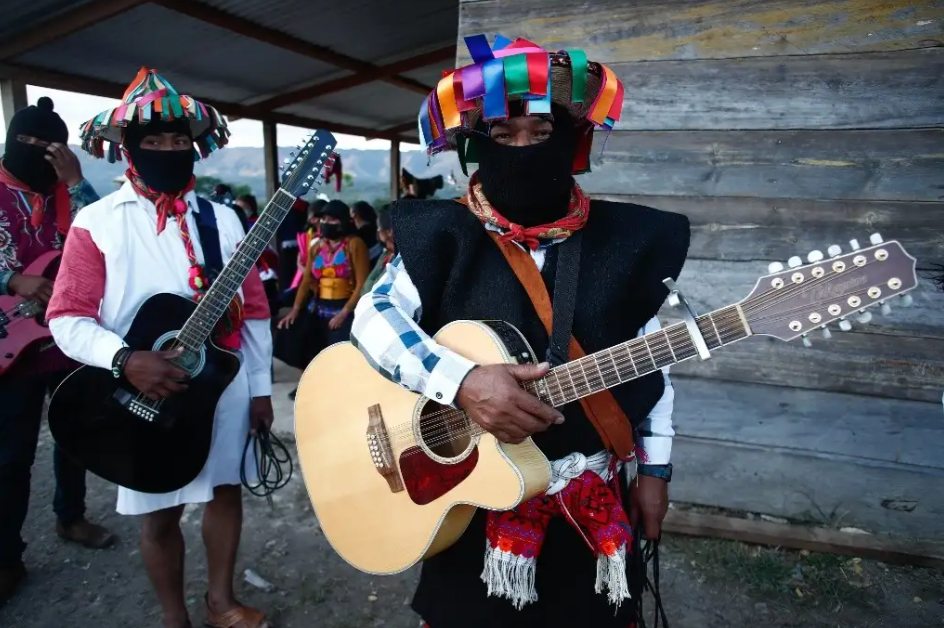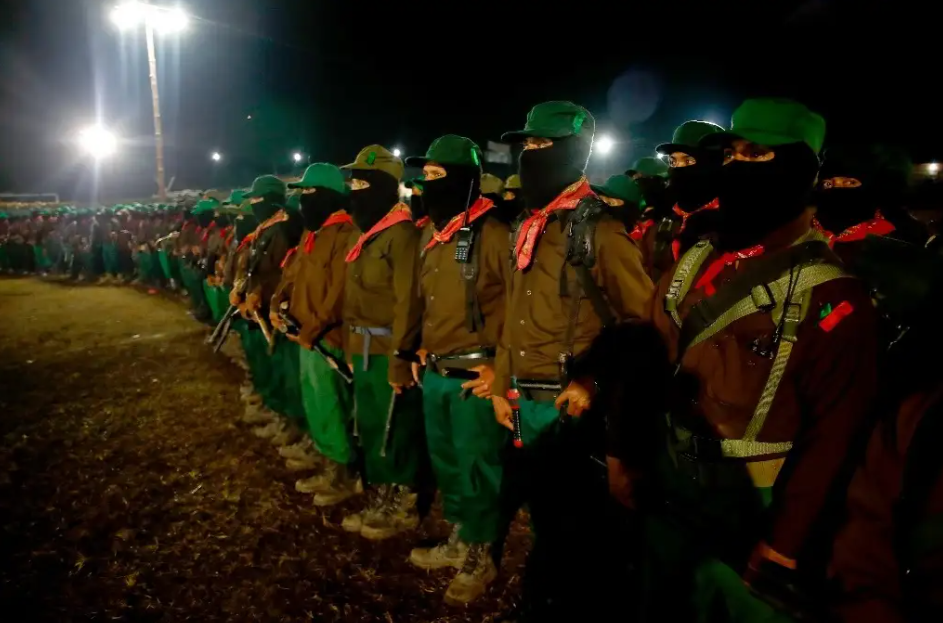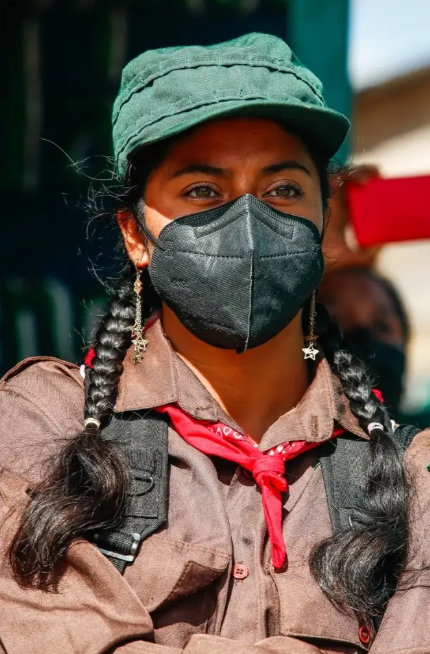Gloria Muñoz Ramirez
Ocosingo, Chiapas. A demonstration of youthful strength, a military parade to the rhythm of Panteón Rococó and Los Ángeles Azules, a massive Zapatista, national and international attendance, and a strong message: “Property must be of the people and in common, and the people must govern themselves, said Subcomandante Moisés, spokesman for the Zapatista Army of National Liberation (EZLN).
The military leader, of Tseltal origin, is an organizer of villages and responsible for explaining inwardly and outwardly the next steps of their struggle.
“The common” was the most mentioned phrase during the two days of celebrations. To explain it they dedicated plays, songs, dances and choral poetry. A resounding we are alone, as 30 years ago, gave an account of the reality they live and feel, but left the door open for their insistent call to organization. “We invite sisters and brothers to come, if they want to come, to share our ideas, to see what is the best for life. What we are saying is that those who work should eat and those who do not work should eat their bills and coins, to see if that will satisfy their hunger.”
The paradoxical spirit of peace of an army that took up arms for freedom, democracy and justice was once again evident. We do not need to kill the soldiers and the bad governments, but if they come, we are going to defend ourselves, Moisés made clear, in an event in which there was not a single weapon, although there were thousands of uniformed men in green pants and brown shirts, the clothing of the Zapatista militia.
At 10:30 p.m. on the last day of the year, the commemoration of the 30th anniversary of the armed uprising of the Mayan peoples of Chiapas began. After an uncommon, joyful and festive parade of thousands of Zapatista militia men and women from a generation that was surely born 10 years after the uprising, Subcomandante Moisés began his political message in Tseltal, speaking first of all to the massive concentration of support bases that traveled to the Dolores Hidalgo caracol, created on reclaimed lands and inaugurated only three years ago.
A row of empty chairs was placed at the front of the pavilion. The “ones who are absent”, reads the sign that presided over them. The disappeared are not here. The political prisoners are not here. The assassinated are not here. The murdered young men and women are not here. The murdered children are not here. Our great-great-great-grandfathers are not here —those who fought more than 500 years ago— but also our fallen comrades who have already fulfilled their duty, are not here, said Subcomandante Moisés. Thirty years ago, Moisés was recognized as a captain, then promoted to lieutenant colonel, and currently holds the highest rank within the military structure of the EZLN.

The festivities took place at the Dolores Hidalgo ‘caracol’ in Ocosingo, inaugurated just three years ago. Photo Victor Camacho
The final speech was preceded by a long cultural program in which the children and youth of the rebel communities staged the history of their autonomy in stages and the initiative they are already working on: Tierra Común. No One’s Land. On this occasion there was no written communiqué nor was there the presence of Captain Marcos, who 30 years ago, and for a long period, was in charge of explaining the word of the peoples to the rest of the world, achieving with his own narrative not only to convey their motives and pains, but a new way of doing politics that does not run along the path of the seizure of power, but that of organization. Marcos only appeared for a few moments during the evening cultural event.
“Compañeros and compañeras support bases, we are committed now. We are alone, as we were 30 years ago. Because alone until now we have discovered this new path that we are going to follow: the common path. Here we still need to see if our compañeros and compañeras of the National Indigenous Congress and the people of Mexico are in agreement,” concluded the Zapatista spokesperson.”
Why we are here
The long-awaited thirtieth anniversary celebration took place with impeccable organization. Hundreds of events preceded it. Insiders and outsiders learn and everything happens in perfect peace. At times one forgets that these lands of green mountains and misty landscapes are part of a state taken over by organized crime, paramilitaries and governments that have been at the forefront of dispossession for decades. Inside, there is no sense of threat. Quite the contrary.
Writer Juan Villoro, actress Ofelia Medina, producer Berta Navarro, actor Daniel Giménez Cacho, filmmakers Valentina Leduc and Juan Carlos Rulfo, and philosopher Fernanda Navarro walk smiling as part of a festivity. They, and many more like them, are also celebrating 30 years of staying close.
The first people to be called upon by the Zapatista struggle arrived here: the indigenous peoples of the country. Nahuas, Purépechas, Nayeris, Binni Záa, Me’phaa, Na savi, Amuzgos, Mazatecos, Popolucos, Chinantecos, Otomíes, Mayos, Yoremes, Zoques, Totonacos and Mayas came to listen to what the work of “Tierra Común/No One’s Land” consisted of.
We don’t need them to come and give us explanations or political statements or workshops on how the system is. It is so simple and we can plainly see how the capitalist system is. Whoever does not want to see will be their responsibility. It’s been many, many years, some say decades and others say centuries, why do we want to be taught a class on that? It is simple to see that what we have to do is for the good of all, to think about the good of all. That is for us to do,” explains Moisés at the microphone. Behind him sit dozens of members of the Clandestine Revolutionary Indigenous Clandestine Committee (CCRI), the highest authority of the entire Zapatista structure.

The event, which began at 10:30 p.m. on Sunday, was attended by thousands of uniformed militants in their characteristic green pants and brown shirts.
Photo: Victor Camacho
“That which we will say that we will make common, maybe there are brothers, sisters, who think otherwise. But no. There are things that are common and there are things that are not common. That is why we have brains, to think, and that is why we have eyes, to take notice. That is why we have a sense of smell, to be able to sense what is common and what is not common,” Moisés continues, and adds that there is no book or manual for what is to come and, as always, everything will have to be tested in practice.

“We don’t need to kill,” insists the Zapatista military commander, “but for that you need organization… We no longer want those who are ruling over there, because capitalism exists in the world… nobody is going to go and fight where everyone lives. It is us there, where you are, where you live. And then he asks: “does anyone believe that capitalism can be humanized?” In chorus the audience answers no. And he continues: “Capitalism is not going to say ‘I renounce exploiting’. Nobody, not even the smallest, wants to stop cheating, stealing and exploiting, not to mention the big guys. So not much study is needed. What is needed is to think about how to change this. Nobody is going to tell us, it is we the people, women and men, who are going to follow this path and defend ourselves.”
The organization, the history and the 4T
During the two days the Zapatistas recounted the different stages in the history of their autonomy, from the birth of the Aguascalientes in 1994, its conversion into five caracoles in 2003, its expansion to 12 and the present day, which is pronouncing itself in favor of the Common Land, without owners, and even inviting those who are not Zapatistas to be part of this collective work.
“It has not been easy, because the bad government has wanted to finish us off. They have militarized, they wanted to divide us. In their media they said that the Zapatistas had surrendered and we accepted their crumbs. But we did not surrender. To resist is not only to endure, but to build,” say the young people in a play.
The time comes for criticism and deep questioning of the 4T and its megaprojects. Cardboard trains carried on the shoulders of children and young people represent the Mayan Train and the Interoceanic Train, recently inaugurated by the federal government. This segment talks about wind projects, mining, transgenic and hydroelectric projects. Also about organized crime and its complicity with governments.
The party seems endless. The dance continues during the early hours of the morning. And throughout January 1st there are new dances, basketball and volleyball tournaments, artistic performances and workshops offered by visitors.
Suddenly, an unlikely group of mariachis appears at the soup kitchen. They sing Las Mañanitas, because they are celebrating a birthday.
Original article published in La Jornada on January 2nd, 2024. https://www.jornada.com.mx/noticia/2024/01/02/politica/estamos-solos-como-hace-30-anos-ezln-9172
English translation by Schools for Chiapas.
